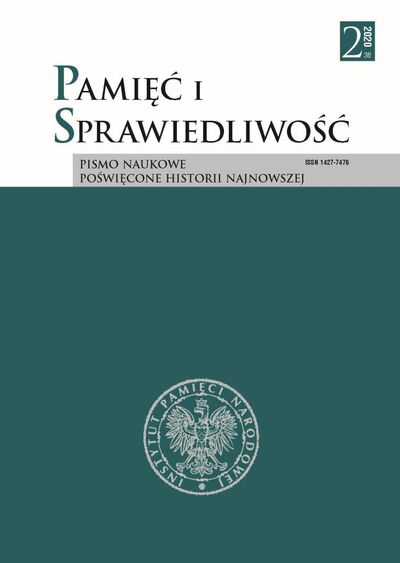Communist Party of Yugoslavia between the Soviet Model and Revolutionary Experience (1945–1948). International Aspects of the Activity of the CPY
Pamięć i Sprawiedliwość, Vol. 36 No 2 (2020), pages: 88-103
Publication date: 2020-12-31
 https://doi.org/10.48261/PIS203606
https://doi.org/10.48261/PIS203606
Résumé
The end of the World War II at the same time marked the beginning of the breakup war coalition. The Soviet Union tried to consolidate its leading position in its own sphere of interest defined by inter-ally agreements made during the war. It was a heterogenous space in the national, political and economic sense where the local Communist parties that were envisaged to be a support to the future Sovietisation of the region, did not have a strong basis. The exceptions were Yugoslavia and, to some extent, Albania. The Yugoslav Communists, who managed to carry out a revolution during the anti-fascist struggle and in an absolutely strategic location, imposed themselves as an important ally. For the Yugoslav Communists, the Soviet Union represented not only an ally, but also the country that was a role model for the future transformation of the Yugoslav State and society, while for the Soviets Yugoslavia was more than a regional partner and faithful ally. Although the newly signed interstate agreements of a political, military and economic character announced the development of future cooperation, already at the beginning of 1947, the first signs of a more serious crisis in Yugoslav- Soviet relations appeared. The crisis had a number of causes, and it also threatened to serious conflict that would have lasting consequences for general relations between the two countries.
Références
Archive of Yugoslavia
Belgrade Historical Archive
Foreign Policy Аrchive of the Russian Federation
Russian Archive of Social and Political History
Jugoslovensko-sovjetski odnosi 1945–1956. Zbornik dokumenata (Beograd, 2010).
Borhi L., Hungary in the Cold War 1945–1956. Between the United States and the Soviet Union (Budapest–New York, 2004).
Bystrova N., SSSR i formirovanie voenno-blokovogo protiostoyaniya v Evrope 1945–1955 gg. (Moskva, 2007).
Dimić L., Agitprop kultura. Agitpropovska faza kulturne politike u Srbiji 1945–1952 (Beograd, 1988).
Dimitrijević B., Jugoslovenska armija 1945–1954. Nova ideologija, vojnik i oružje (Beograd, 2006).
Dimitrijević B., Jugoslovensko Ratno Vazduhoplovstvo 1942.–1992. (Beograd, 2006).
Gaddis J., The Cold War (London, 2005).
Kennan G., Realities of American Foreign Policy (New Jersey, 1954).
Miloradović G., Lepota pod nadzorom: sovjetski kulturni uticaji u Jugoslaviji 1945–1955 (Beograd, 2012).
Perišić M., Od Stalina ka Sartru: formirane jugoslovenske inteligencije na evropskim univerzitetima 1945–1958 (Beograd, 2008).
Petranović B., Dautović, S., Jugoslavija, velike sile i balkanske zemlje, 1945–1948. Iskustvo «narodne demokratije» kao partijske države (Beograd, 1994).
Selinic S., Zivotic A., “Conversation Between Soviet and Yugoslav Delegation in Moscow (27 May – 12 June 1946)”, Bulgarian Historical Review 2009, no. 1–2.
Weastad O.A., The Global Cold War. Third World Interventions and the Making of Our Times (London, 2005).
Zubok V., Pleshakov K., Inside the Kremlin’s Cold War: From Stalin to Khrushchev (Cambridge, 1996).
Životić A., Jugoslavija, Albanija i velike sile (Beograd, 2011).
Licence
(c) Tous droits réservés Pamięć i Sprawiedliwość 2023

Ce travail est disponible sous licence Creative Commons Attribution - Pas d'Utilisation Commerciale - Pas de Modification 4.0 International.
 Język Polski
Język Polski
 English
English
 Deutsch
Deutsch
 Français (France)
Français (France)
 Italiano
Italiano
 Русский
Русский



 PDF (English)
PDF (English)




